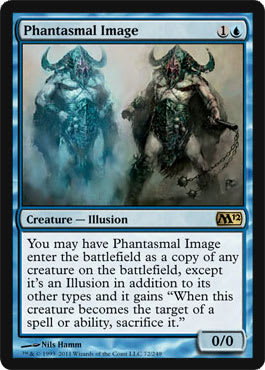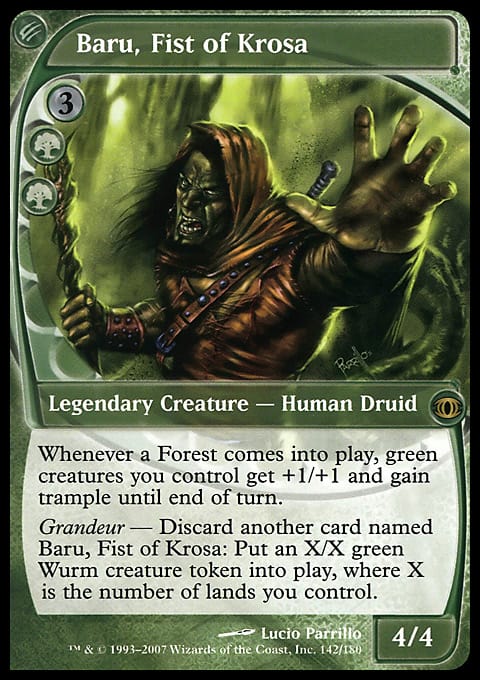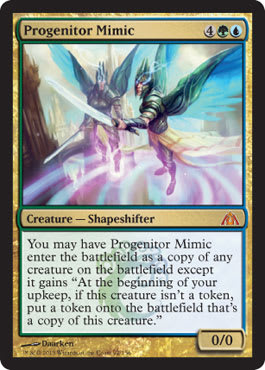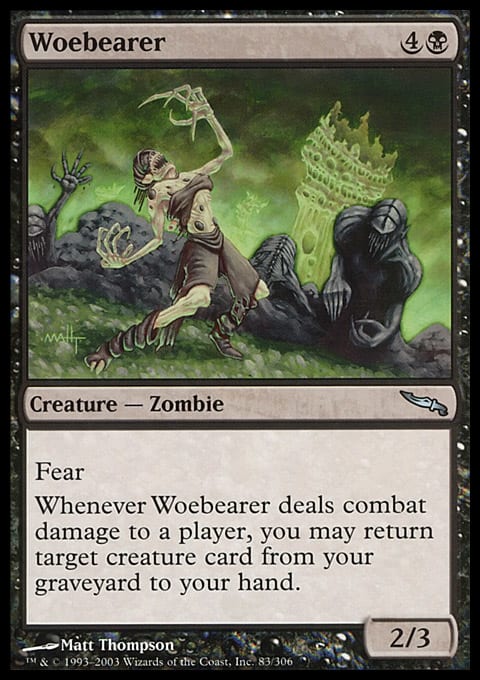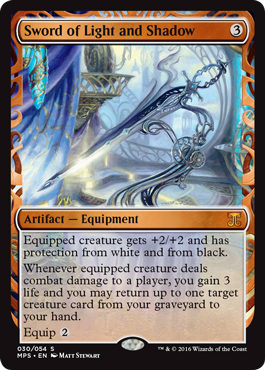It’s no secret that I love figuring out ways to do things that are supposed to be impossible. I’ve made a deck using both Goblin Recruiter and Dwarven Recruiter; I’ve used Phage the Untouchable as a commander; I’ve made use of Mishra, Artificer Prodigy’s ability in singleton (twice).
Apparently, some of you enjoy that stuff, too, because Neoryujin made a comment on last week’s article with #julesrobinsfacts (much like Rob Castellon, I am a judge). Among these facts was “Jules can build a Commander deck with a legendary creature with grandeur (i.e. Korlash, Heir to Blackblade) and make grandeur work nonetheless.” Well, I wouldn’t want to disappoint you. What do we need to do to use grandeur?
- Have the legend on the battlefield
- Have the same legend in hand
Hmm, those do seem to be mutually exclusive . . . I did some finagling and found a solution, but it was a bit too involved to be worth pursuing in an actual game of Magic. And then: divine intervention:
– Matt Tabak in Magic 2014 Core Set Rules Preview
Copy That
Suddenly a Clone, which used to get us nowhere, lets us go from one creature with grandeur on board to one on board and the original in the graveyard!
Of course, they require blue mana, and Linessa, Zephyr Mage doesn’t hold the title for having the most fun or exciting grandeur ability. If only there were some sort of multicolored Clone that we could run as a commander—preferably with some sort of scaly predator for an appendage . . .

The Mimeoplasm by Svetlin Velinov
Sure, we don’t want to use The Mimeoplasm to exile the grand legends themselves, but with the number of board wipes running around the format, it shouldn’t be much trouble to rebuy a Clone from our graveyard . . . or from someone else’s. On top of that, B/U/G gives us access to an excellent pair of grandeur-endowed creatures.
And the additions to the Clone department aren’t too shabby either.
Speaking of which, running a bunch of Clones is a perfectly reasonable strategy even when they don’t feed a specific game plan. Somebody is bound to have a Duplicant or a Primordial to copy, so our “extra” Clones will do plenty. Vesuvan Doppelganger and Vesuvan Shapeshifter can even deliver an enters-the-battlefield trigger before turning into a legend, which contributes to the main objective.
Which is, um, uh . . . it’s time to reformulate the list:
- Have a legend on the battlefield and in the graveyard simultaneously. Check!
- Return a legend from graveyard to hand.
If You Strike Me Down Now . . .
The second item doesn’t present much of a conundrum. Raise Dead has been around forever. Of course, grandeur effects are only supposed to make up for one card’s value, so we probably need our Disentombs to be repeatable in order to make them worthwhile.
But such a potent effect often requires us to jump through hoops—for instance, dealing combat damage . . .
. . . or giving our opponents the ability to recur their creatures, too:
Fortunately, The Mimeoplasm can solve either of these issues by turning into something evasive or exiling the good creatures in other players’ graveyards. That leaves us free to bring back Korlash, Baru, and Linessa over and over again for their grandeur abilities. There’s just one question: Where does that actually get us?
The result depends on which one we’ve been recurring: a tempo speed bump for some opponents, a couple of creatures, or a few extra lands. Wait, did I say a few extra lands? That’s not right. Many of the ways to recur Korlash can be repeated with more mana, meaning the first extra lands let us use him more and more times, quickly grabbing all of our Swamps.
The Big Picture
After that Baru’s grandeur becomes much more appealing since now the Wurms will be enormous. But Baru doesn’t have a monopoly on making giant critters.
What’s more, there are other things worth doing with a ton of lands.
- Make yet more mana with Cabal Coffers
- Make swarms of tokens with Orochi Hatchery
- Make something huge with Nightmare Lash
- Draw cards with Mind Spring
- Steal a deck with Geth, Lord of the Vault
So, there’s the basic game plan: Clone Korlash, return and discard him repeatedly for lands, and then do something crazy. Project Grandeur: successful.
But this deck needs more than just that one plan. Breaking the rules of possibility is cool, but a Commander deck should be fun the second, third, and fifty-fourth time you play it. That requires a little bit more flexibility. How else can we use the cards involved?
Other Plans
If we Clone and Disentomb a different legendary creature instead of one with grandeur, we can recast it and then rinse and repeat. Normally, that wouldn’t do much, but going through the motions with Kokusho, the Evening Star will drain a bunch of life; Verdeloth the Ancient can make a lot of tokens every turn; and Prime Speaker Zegana draws more cards with each iteration by alternating which copy we keep in play.
But really, this deck can operate on just about any game plan. Just pick an opponent who has something cool going on, and start copying his or her creatures! No cool synergies cropping up? Play some good, old-fashioned Commander by ramping, making The Mimeoplasm into various giant creatures, drawing cards, and destroying permanents.
Squeeze all of those capabilities together into a hundred cards, and you end up with something like this:
Grandiosity
- Commander (0)
- Grand Opening (3)
- 1 Korlash, Heir to Blackblade
- 1 Baru, Fist of Krosa
- 1 Linessa, Zephyr Mage
- Regular Customer (13)
- 1 Oath of Ghouls
- 1 Sword of Light and Shadow
- 1 Undertaker
- 1 Woebearer
- 1 Tortured Existence
- 1 Disturbed Burial
- 1 Grim Harvest
- 1 Endbringer's Revel
- 1 Phyrexian Reclamation
- 1 Genesis
- 1 Paleoloth
- 1 Rings of Brighthearth
- 1 Illusionist's Bracers
- Chain Store (12)
- 1 Body Double
- 1 Cackling Counterpart
- 1 Rite of Replication
- 1 Spitting Image
- 1 Stolen Identity
- 1 Progenitor Mimic
- 1 Phantasmal Image
- 1 Phyrexian Metamorph
- 1 Vesuvan Doppelganger
- 1 Vesuvan Shapeshifter
- 1 Evil Twin
- 1 Clone
- Restock (10)
- 1 Diviner's Wand
- 1 Braingeyser
- 1 Mind Spring
- 1 Stroke of Genius
- 1 Diabolic Revelation
- 1 Prime Speaker Zegana
- 1 Rune-Scarred Demon
- 1 Brutalizer Exarch
- 1 Corpse Connoisseur
- 1 Riptide Shapeshifter
- Blowout Sale (14)
- 1 Allosaurus Rider
- 1 Avenger of Zendikar
- 1 Budoka Gardener
- 1 Geth, Lord of the Vault
- 1 Orochi Hatchery
- 1 Riptide Replicator
- 1 Nezumi Graverobber
- 1 Gelatinous Genesis
- 1 Verdeloth the Ancient
- 1 Lashwrithe
- 1 Nightmare Lash
- 1 Sigil of Distinction
- 1 Kokusho, the Evening Star
- 1 Tendrils of Corruption
- Market Share (47)
- 1 Reap and Sow
- 1 Expedition Map
- 1 Sylvan Scrying
- 1 Life from the Loam
- 1 Amulet of Vigor
- 1 Boundless Realms
- 1 Genesis Wave
- 1 Bojuka Bog
- 1 Sunken Ruins
- 1 Twilight Mire
- 1 Flooded Grove
- 1 Command Tower
- 1 Overgrown Tomb
- 1 Watery Grave
- 1 Slippery Karst
- 1 Tranquil Thicket
- 1 Remote Isle
- 1 Lonely Sandbar
- 1 Breeding Pool
- 1 Simic Guildgate
- 1 Simic Growth Chamber
- 1 Dimir Aqueduct
- 1 Golgari Rot Farm
- 1 Bayou
- 1 Underground Sea
- 1 Verdant Catacombs
- 1 Polluted Delta
- 1 Bloodstained Mire
- 1 Marsh Flats
- 1 Cabal Coffers
- 1 Vesuva
- 1 Thespian's Stage
- 1 Deserted Temple
- 1 Urborg, Tomb of Yawgmoth
- 13 Swamp
Odds and Ends
The last order of business is to explain some of the card choices that aren’t easily extrapolated from the above rundown.
First up is Paleoloth. Paleoloth? Surely that falls into the “easily extrapolated” category. It returns creatures to discard for grandeur. That’s true, but remember that we’re also running a bunch of Clones. Paleoloth can quickly recur all of our dead creatures by playing Clones as copies of Paleoloth, so each one will return one more dead creature than the last.
Amulet of Vigor lets the lands Korlash fetches come out untapped, making it much easier to chain grandeur activations. For instance, with Endbringer's Revel, the extra mana will allow us to search up twice as many Swamps! It also makes Geth, Lord of the Vault really difficult for our opponents to play around.
Illusionist's Bracers and Rings of Brighthearth both promise more grandeur effects, and there are enough activated abilities floating around the deck to make them useful elsewhere.
Riptide Shapeshifter may seem out of place, but despite appearances, it’s actually a Cloneable tutor! Baru, Fist of Krosa is the only Druid in the deck, Korlash is the only Warrior, Undertaker is the only Spellshaper, and every other Shapeshifter is a Clone variant. That means Riptide Shapeshifter can pick and choose whichever piece we’re missing or just fetch something unknown.
If there’s something really juicy to Clone on the board, we can target ourselves with Linessa, Zephyr Mage’s grandeur ability to bounce a Clone and a land that we can discard to retrace Spitting Image, netting two enters-the-battlefield triggers and one additional copy on board.
The End of the Day
I hope you’ve enjoyed this foray into the land of impossibility, but more than that, I hope you’ve taken one thing away from it: You can’t know that something’s impossible until you give it a shot. So go out, find something that conventional wisdom says you can’t do, and do it anyway.

















